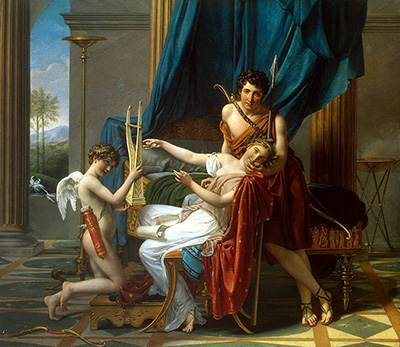 Buy Art Prints Now
Buy Art Prints Nowfrom Amazon
* As an Amazon Associate, and partner with Google Adsense and Ezoic, I earn from qualifying purchases.
Sappho was a brilliantly skilled poet even being called, in her lifetime, the tenth muse. She was also, arguably, the world's first lesbian.
Arguable in the eyes of the (mainly male) historians, poets and researchers who have come across her in the various histories of her life as well as the many plays, poems and paintings based on her and her life. There was an unfortunate tendency to dismiss any evidence in favour of her erotic love for women, and she was claimed to be, variously: a teacher – hence her devotion to her 'girls'; a promiscuous heterosexual – hence her reputation for deviancy; and just a very good friend to her women friends about whom she wrote the most wonderful poems!
It is upon this determination to fit Sappho into the heterosexual box that this painting is based. While Sappho was a real person, Phaon was most likely not – or his story is not, at least. Reputedly, Phaon was a ferryman who had become old and wrinkled. Aphrodite, travelling in disguise as a crone used his services to cross from Lesbos (Sappho's home) to Asia Minor. For whatever reason, Phaon refused any payment from the love goddess, and as a reward she gifted him a magical lotion. He applied it to his whole body and was restored to his prime, bursting with youth and beauty.
When Sappho saw the handsome young boatman, she fell in love and they – ahem – enjoyed each other's company for a time. But then Phaon became bored with her and broke up with her. Sappho, the legend goes, was so distraught by this that she threw herself into the sea asked to be cured of her love or drowned. She drowned. Needless to say, this story is mere myth and rumour and nothing about Phaon's life can be confirmed at all.
This painting, called Sappho and Phaon, depicts the couple during the time of their affair. Sappho is reclining in a chair, her head tilted back and turned into Phaon's cupping hand. But he does not particularly tender towards her, instead looking out towards the viewer, eyelids heavy and disinterested. Sappho's arms are raised as though asking for help, and one of her breasts is peeking out from her flowing white gown – she is the picture of a helpless woman, fully under the control of her man. (This is something that David portrayed a lot: strong virile men and weak, helpless women, especially in his earlier paintings.
After his marriage and the birth of his children, he softened a little towards the fairer sex, portraying men in a softer vein and women now as their almost equals.) Cupid stands in front of Sappho upon whose lap lies a poem, perhaps indicating that she was abdicating her art for her man. Despite the chilling imposition of a heteronormative view on the Greek poet, the painting is beautifully executed. It is immense, oil on canvas, standing 225.3cm x 262cm. It is the only David painting to be found in its current home: the Hermitage Museum in Saint Petersburg.




